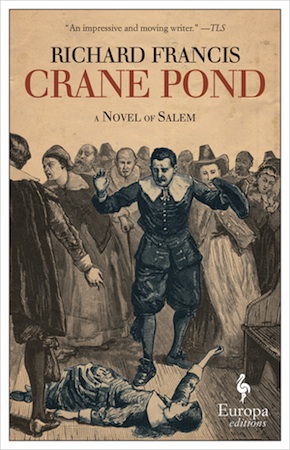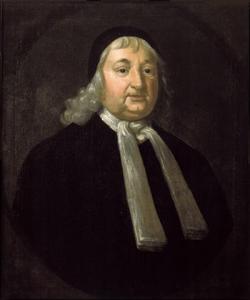Delusions of a terrorised conscience
by Mika Provata-Carlone
“A thrilling new telling of one of America’s founding stories.” goodreads.com
“I desire to be humbled before God. It was a great delusion of Satan that deceived me in that sad time. I did not do it out of anger, malice, or ill-will,” stated Ann Putnam in 1706. When only twelve or so, she had been one of the principle witnesses and accusers in the notorious Salem witch trials of 1692–3. On the strength of her evidence, which consisted of near-epileptic fits, contortions, anecdotal accounts of spectral apparitions, rituals of witchcraft and demonic influences, fourteen women and five men died by hanging as witches and wizards; one man was “pressed to death”, succumbing under the eloquently termed peine forte et dure; five more died in prison, including two infant children; a girl of four, the daughter of one of the suspected witches, Sarah Good, was herself accused of sorcery and was imprisoned. The sources relate that she cried as she watched her mother being carted to the gallows, until she became insane. Two dogs were also executed, as ‘familiars’.
And yet, the Salem trials can be said to have had nothing specifically unique about them: twelve women had been executed shortly before in the states of Massachusetts and Connecticut, and between the 14th century and the late 18th, witch hunts were a common practice across Europe: 110,000 people were prosecuted in court and 40,000–60,000 were executed formally, besides the numberless unknown who perished through mob lynching or otherwise. Two thirds of the witch hunts took place in Germany, the Low Countries, France, northern Italy and Switzerland, where the last execution was held as late as 1782. What does, however, make the Salem trials a phenomenon of true horror is their context, the social and political environment that fostered them and made them a central concern; the ideological, ethical, religious and societal precepts that made them inevitable, and especially the ‘moment after’. Ann Putnam’s simple statement of remorse is rare among the participants. Samuel Sewall, the protagonist of Richard Francis’ Crane Pond, made the only other public declaration and admission of no less than criminal guilt with regard to the very notion itself of the trials.
“Every action is weighed, each and every one, however small, and sometimes you can’t tell which way the scales have moved,” Sewall ponders early in the story, “we must all pay attention to the meaning.” And this is a historical novel that fleshes out every single detail of that dehumanising moment in time. It is also a humane as well as shrewd exploration of a man’s psyche and conscience, an inward journey into causes, rationales, justifications and, very crucially, both human and divine justice: “justice is impersonal after all,” which is why hanging was deemed the most preferable method. Yet should it also lack a human face?
The paralysing effect of mob psychology and the shocking passive acceptance of brutality make Crane Pond a profoundly thoughtful, gripping, at times harrowing reading experience.”
Crane Pond is a quiet narrative about howling fear and mass hysteria; it is a serenely paced logbook of individuals and a slice of humanity in extreme turmoil and crisis. Francis is primarily a historian, a scholar specialising in that period of American history. In Crane Pond he leaves us gasping with horror at the unproblematic normalisation of terror, at the mundane nature of evil, at the ultimate apparent inconsequence of acts of sheer cruelty and of crimes against humanity. Time passes; memory lapses; life resumes its course. In 1711, 22 of the 33 convicted were exonerated and a compensatory sum of £578 12s was divided among the victims’ families; the remaining 11 had to wait until 2001 to be purged of the stain of witchcraft.
It is precisely this reflection on what makes such acts conceivable and possible in a social community, minute step by minute step, which distinguishes Francis’ novel. Instead of being another dramatisation of the circumstances, or using them as metaphors, as Arthur Miller and Margaret Atwood have done, sublimely and devastatingly, Francis sticks to the facts. He does not allow us to escape the reality of deliberation or the delusion of motivation involved, he asks us to consider contextual and absolute ethics equally and creates with vigour as well as equanimity a pageant of a religious system and of a colony in dire crisis; a Bruegel reflection on the consequences of divesting ethics of their human purpose. It is easy to see in the Salem trials a caricature of the Age of Enlightenment and of the American Dream, of Reason that even under the guise of piety has morphed into a monster of totalitarian machine logic. But it is also necessary to see the spiritual dimension and agony in the excessive self-questioning, analysis, deferral of the self in scriptural metaphors; in the desperate attachment to literalness, to the physical and pragmatically attested experience of grace, to the covenant of ascetic epiphany that was the Puritan reaction to secularism and materialism. New England is essentially, as Francis subtly shows, a new world of old men, as well as an old world full of very real danger.
There is evident pleasure in the art of writing, in the choosing of words and images, also in the recollection of an era, in the materialisation of historical research. This is a carefully embroidered narrative, a tapestry woven with a sense of decorum but also with effortless simplicity. The poise of Puritan lives and their austerity, but also their inherent, resonant humanity, is granted voice, new presence beyond stereotypes, facile grotesqueness or misconceptions. The ambiguity of Samuel Sewall’s life as an affluent merchant, upstanding citizen, printer and writer of anti-slavery pamphlets, private family man and secretary to the trials, becomes the prism through which Francis can examine the “lie [that] has now become entrenched or… has mutated into truth” – the black arts of social hatred, mass hysteria, racism, the Goyesque mistrust of the natural as well as the supernatural.
Slow, cinematic motion that captures the paralysing effect of mob psychology, that focuses alternately on moments of light and darkness, on the trivia of everyday life (should one use a cushion to make kneeling in prayer less painful for a corpulent old man?) and on the shocking long hours of passive acceptance of brutality, makes Crane Pond a profoundly thoughtful, gripping, at times harrowing reading experience. We walk on the dusty or muddy streets savouring pasties or feel claustrophobically trapped in the mandatory, countless dark cupboards of revelation. We live ‘the New England way’ in the promised land of America – a fundamental precept of Puritan doctrine, where the departure from England was not perceived as a forced exile but as an escape with a holy mission: the building of a world of predestination, fulfilling the covenant between God and his elect through justification and sanctification, realising the covenant of redemption. The foundation narrative of the early colonies is a conversion narrative, where even measures of a ‘half-way covenant’ were devised in order to separate with unity: contradiction was organically embedded in both life and faith.
A few years before the trials, Rembrandt painted The Return of the Prodigal Son (1668), John Bunyan, more pertinently, wrote Pilgrim’s Progress (1678) and Newton published his Principia Mathematica (1687). In 1690 Corelli composed his Concerti Grossi and in 1691 the Spanish Inquisition burned 37 heretics and Jews. Following the trials, Peter the Great will become Tsar of Russia in 1696, Perrault will write his Mother Goose tales a year later, the same year as the opening of St Paul’s Cathedral in London, and the completion of the Spanish conquest of South America. And in 1699 Swift will begin to write what is perhaps the ultimate survey of the times, Gulliver’s Travels. Closer to home, Massachusetts is under attack by native Indian tribes supported by the French. Consecutive catastrophic defeats have marked the very recent past of the trials, and it is a profoundly unnerving historical conclusion that much of the urgency behind a public display of successful salvation and defence of the community comes from this series of military failures, a theory poignantly put forth in Mary Beth Norton’s In the Devil’s Snare (2002). Most of the judges, Norton shows, had held key positions in this pointedly disastrous war campaign. Even more unsettling is the social subtext of the trials and the socioeconomic profile of accusers and accused. Putnams were pitted against Proctors, personal foes were indicted with sinisterly evident prominence, the accused are usually the more affluent, the more successful. Pettiness and spite acquire pathological maleficence and tremendousness in Salem Village, now Danvers, Massachusetts.
Francis is particularly skilful in interweaving every thread of philosophical interlining and historical dilemma in his novel. For this is the perhaps the most disturbing aspect of the trials: their philosophical underpinning, the mental stamina and intellectual magnitude of most of the principle decision-makers: they were men educated in the finest institutions, who then went on to found other great places of learning and reflection. Yet these men believed the unbelievable, forced truth through untruth, distorted evidence, confession, statement into the most contorted positions. Unheeded; unblushing; unperturbed, as Francis brilliantly makes us feel. In a shocking twist on Rousseau’s theory of the noble savage and Emile (to appear 70 years later), innocence is deemed a state of preternatural vacuum, susceptible to the worst figments of evil. Children are incorporeally idolised, and in their primal innocence, in their quality of existing between the world of shadows and the world of men, the screaming of bats and the voice of a mother singing become the primary carriers of the contagion: squashed by a regime of exposure and darkness, they become hysterical, hypocritical, hypochondriac. A child’s question reveals all that is hidden in the edifice of sublime piety and the later ‘sermons of terror’ of the Great Awakening: “If we are all elected, then why are the witches witches?”
Francis asks questions about noble intentions and failed application; about spiritual decay in the crusade for perfect purity, in the agon that is no less than “the spiritual enterprise of a holy generation.” How does an individual, a nation, progress from ‘holiness’ to humanity? Especially in a society of fear and righteous (self-)punishment, of constant, unalleviated doubt and a sense of inexorable causality? Delicately, uncompromisingly, Francis suggests that Samuel Sewall may be the answer. The Salem trials were followed by a period of atonement, their fire extinguished as soon as it had been lit. This is a thoroughly intelligent, rich, fascinating book, the beginning of many trains of thought and perhaps self-explorations of conscience.
 Richard Francis was educated at Cambridge and Harvard. He has written 17 books, both fiction and non-fiction, including many on American history and thought. He and his wife live in Bath. Crane Pond is published by Europa Editions. Read more.
Richard Francis was educated at Cambridge and Harvard. He has written 17 books, both fiction and non-fiction, including many on American history and thought. He and his wife live in Bath. Crane Pond is published by Europa Editions. Read more.
richardfrancis.wordpress.com
Mika Provata-Carlone is an independent scholar, translator, editor and illustrator, and a contributing editor to Bookanista. She has a doctorate from Princeton University and lives and works in London.


